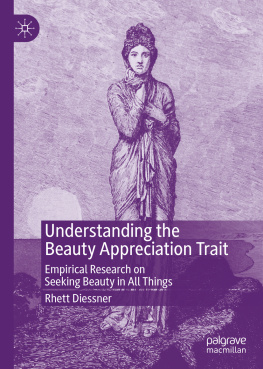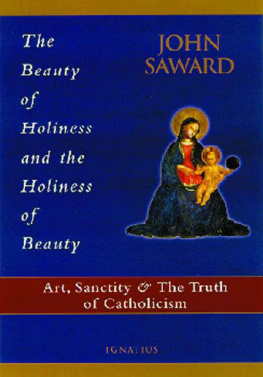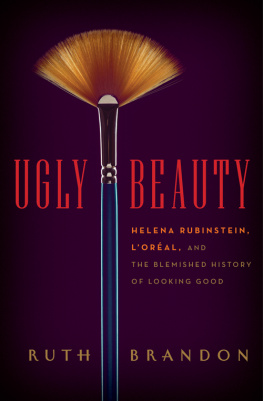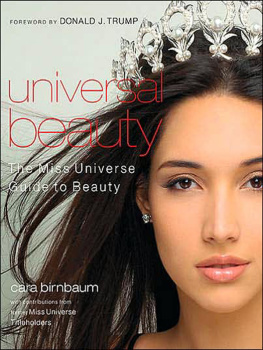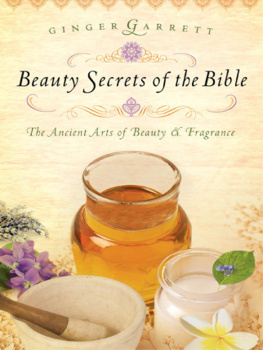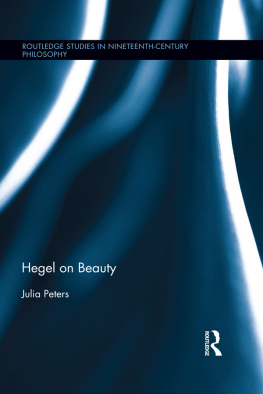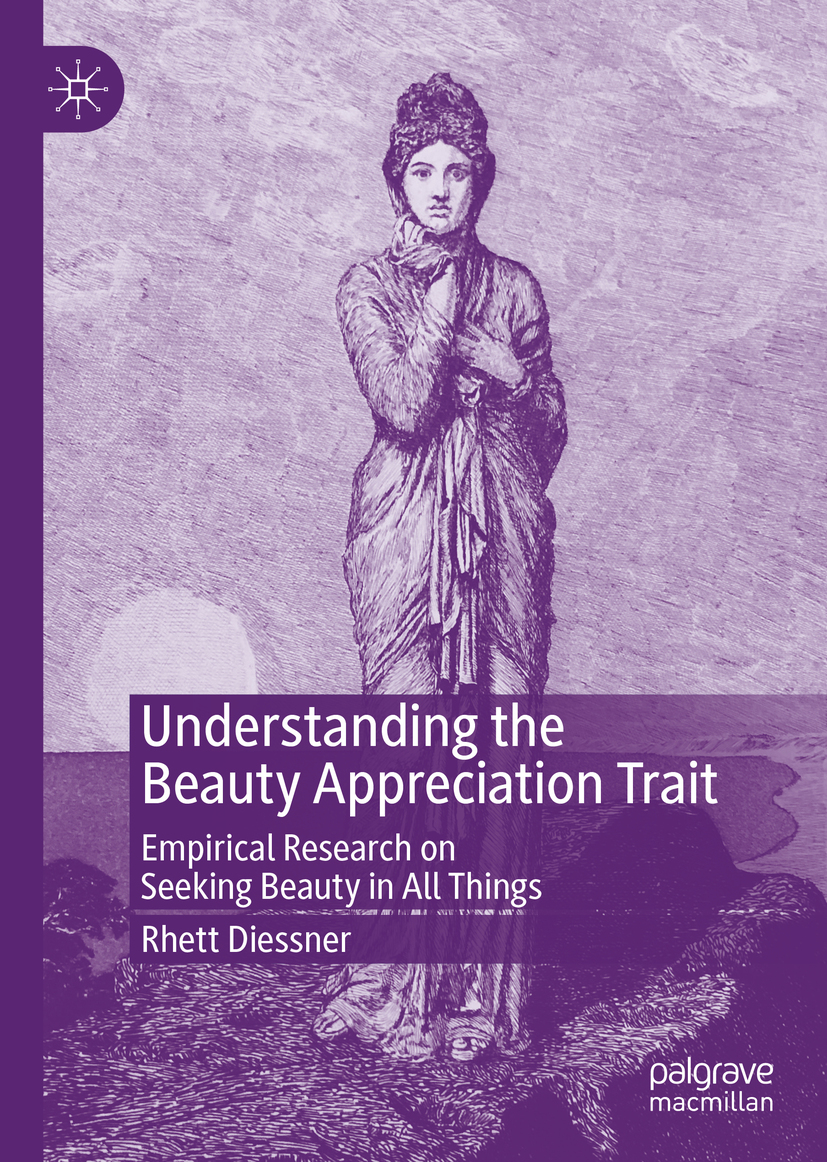Rhett Diessner
Understanding the Beauty Appreciation Trait
Empirical Research on Seeking Beauty in All Things
Rhett Diessner
Lewis-Clark State College, Lewiston, ID, USA
ISBN 978-3-030-32332-5 e-ISBN 978-3-030-32333-2
https://doi.org/10.1007/978-3-030-32333-2
The Editor(s) (if applicable) and The Author(s), under exclusive license to Springer Nature Switzerland AG 2019
This work is subject to copyright. All rights are solely and exclusively licensed by the Publisher, whether the whole or part of the material is concerned, specifically the rights of translation, reprinting, reuse of illustrations, recitation, broadcasting, reproduction on microfilms or in any other physical way, and transmission or information storage and retrieval, electronic adaptation, computer software, or by similar or dissimilar methodology now known or hereafter developed.
The use of general descriptive names, registered names, trademarks, service marks, etc. in this publication does not imply, even in the absence of a specific statement, that such names are exempt from the relevant protective laws and regulations and therefore free for general use.
The publisher, the authors and the editors are safe to assume that the advice and information in this book are believed to be true and accurate at the date of publication. Neither the publisher nor the authors or the editors give a warranty, expressed or implied, with respect to the material contained herein or for any errors or omissions that may have been made. The publisher remains neutral with regard to jurisdictional claims in published maps and institutional affiliations.
Cover illustration: photographed by Heidi Simmons
This Palgrave Macmillan imprint is published by the registered company Springer Nature Switzerland AG.
The registered company address is: Gewerbestrasse 11, 6330 Cham, Switzerland
This book is very interesting and engaging to read. It will definitely be a great resource for students.
Ines Schindler,Senior Research Fellow at the Max Planck Institute for Empirical Aesthetics, Germany
Plato once wrote The object of education is to teach us to love what is beautiful. Professor Rhett Diessner does this with great insight, passion and clarity. He writes of how beauty can be studied, codified, learned from and wondered at. But more importantly, he holds it up as a beacon that unites us all and shines through science, art and goodness itself. Also, hes my uncle.
Rainn Wilson, Actor (notably Dwight Schrute fromThe Office)
I dedicate this book to my Best Beloved, the Artisan; and to my best beloved Wendy, who has taught me so much about every kind of beauty; and to my sister Lani, for talking to me about Cezanne when I was fourteen.
Acknowledgments and Gratitude
Julia Barrett and Tyler, Riggs, and Boone (for two years of Fridays full of poetry, music, and art); the Delva Family (for so many spiritually beautiful Wednesday evenings in your home); Rachelle and Jake Genths (for being beautys cheerleaders); Angelika Gsewell (for all the unheard beautiful music and for being such a beautiful colleague); Jonathan Haidt (for many years of encouragement and forelevation); Andrew Hanson (so many years of beautiful lunchtime conversations); RJ and Jess Harper (for beautiful nature and beautiful spirituality); Ravi Iyer (for long-term altruistic support of my Labs beauty research); Peter Khan (editor extraordinaire ofEcopsychology, and for believing I had something evocative to say about natures beauty), Kavous Monadjemi (sigh); Naim Nabil-i-Akbar (for teaching me about spiritual, musical, poetic, and linguistic beauty); Ferris and Linda Paisano (for your spiritual beauty and all the beautiful adventures we had together over decades; may your wisdom guide the Nez Perce Tribal Executive Committee); Bob and Patty Parrish (for doing your best to help me appreciate the beauty of Jazz, and your beautiful photography, and your skills in gustatory beauty); Rico Pohling (for beautiful collegiality in all things beautiful; may the Buddha ever bless you. Go Katrin!); PSYC 414 Psychology of Beauty students (for taking a chance with a strange course and teaching me about teaching beauty); Tim Richel and Yuki and Lio (for our adventures in beautiful philosophical ideas); Julio and Paola Savi (for mentoring me concerning every mode of beauty: natural, artistic, moral, and spiritualand for teaching me a lived aesthetic attitude and hugely influencing my aesthetic emotion repertoire); Noah and Lana Schuerman (for natural and musical beauty); Jordan Tomczyk (for your beautiful friendship and beautiful music); and Rainn & Holiday & Walter Wilson (for your beautiful thespian work and your beautifully actualized love of our family and Holidays beautiful writing).
Special appreciation of my children Jaleh, David, and Random; our love for each other has been wonderful for me and is beautiful.
Much gratitude for reading and commenting on earlier drafts of all or various chapters: Kianna Arthur (most thorough!), Catherine Baumgartner, Random Diessner, Wendy Diessner, Christoph Klebl, Julio Savi, Heidi Simmons, Ines Schindler, Naoaki Takeda, and Oshin Vartanian. Special thanks to Adan Saucedo for preparing the author index. You all improved the book; all infelicities are mine.
I also thank my editor at Palgrave Macmillan, Rachel Daniel, for approaching me and suggesting this project; and I thank my assistant editor Madison Allums for all her patience and answering a thousand emails of questions.
About the Author
I love beauty. I love the beauty of nature. I love the beauty of art and design. I love beautiful virtues, that is, moral beauty. I especially love beautiful ideas. I love spiritual beauty. I love this beautiful Din (Navajo) prayer that my mother used to read to me when I was a child:
In beauty happily I walk.
With beauty before me I walk.
With beauty behind me I walk.
With beauty below me I walk.
With beauty above me I walk.
With beauty all around me I walk. (Jones, 1951, p. 12)
A life of lived-beauty seems much more important than reading or writing
aboutbeauty. Why write a book
aboutbeauty? The great educational philosopher from Stanford University, Nel Noddings (1992), has elucidated that the most important part of any schools curriculum is to teach students to care. I think of
careas the behavioral manifestation of
love. Noddings has explained that when we care about something we want to know more about it and we become intrinsically motivated to seek knowledge about what we care about. This book describes what I have come to
knowabout what I
love.
References
Jones, J. O. (Ed.). (1951).This is the way. Prayers and precepts from world religions.New York: Viking Press.
Noddings, N. (1992).The challenge to care in schools. An alternative approach to education. New York: Teachers College Press.
Contents
Part IFoundations
Part IIDomains of Beauty
Part IIIHuman Development and Beauty

